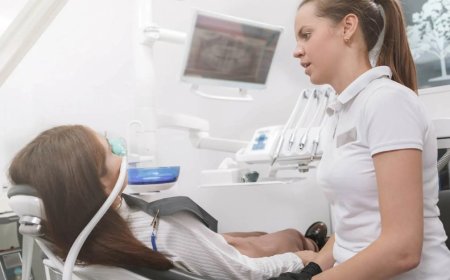How Parkinson’s Affects Movement and Daily Life
Learn about muscle rigidity, its causes, symptoms, and effective treatments to improve mobility, comfort, and daily quality of life.

How Parkinsons Affects Movement and Daily Life
Parkinsons disease is a progressive neurological disorder that primarily impacts movement. While tremors are one of the most recognizable symptoms, the diseases effects go far beyond shaking hands. From walking and balance issues to changes in speech, mood, and even cognitive abilities, Parkinsons can gradually affect nearly every aspect of a persons daily life.
In this article, well explore how Parkinsons disease affects the body and mind, and what strategies can help patients maintain their independence and quality of life.
What Is Parkinsons Disease?
Parkinsons disease is a chronic disorder of the central nervous system, caused by the gradual loss of dopamine-producing neurons in the brain. Dopamine is a neurotransmitter that plays a vital role in regulating movement, mood, and coordination.
The exact cause of Parkinsons is unknown, but a combination of genetic and environmental factors is believed to contribute. While it primarily affects people over the age of 60, younger individuals can also develop the conditiona form known as young-onset Parkinsons.
How Parkinsons Affects Movement
Movement problems are often the earliest and most noticeable signs of Parkinsons. These symptoms worsen over time and can significantly interfere with a persons ability to perform everyday activities.
1. Tremors
Tremors often start in one hand or foot, especially while the limb is at rest. This "resting tremor" is a hallmark of Parkinsons and can spread to other limbs as the disease progresses.
2. Bradykinesia (Slowness of Movement)
Bradykinesia refers to the gradual slowing down of physical movement. Everyday tasks like buttoning a shirt, brushing teeth, or writing can become time-consuming and frustrating.
3. Muscle Rigidity
Stiffness or rigidity in the limbs and trunk is common, making walking and arm movement uncomfortable. This stiffness can lead to a stooped posture and restricted range of motion.
4. Balance and Coordination Problems
Parkinsons affects the bodys ability to maintain balance, leading to frequent falls. Coordination becomes impaired, especially in the later stages of the disease, increasing the risk of injury.
5. Gait Changes
The characteristic Parkinsons gait includes shuffling steps, reduced arm swing, and a tendency to freeze mid-step. Some people may experience sudden episodes where they feel glued to the floor.
Impact on Daily Life Activities
As Parkinsons progresses, it increasingly disrupts a persons ability to manage daily routines, personal care, and interactions.
1. Dressing and Grooming
Fine motor skill impairment makes simple grooming taskssuch as tying shoelaces, buttoning clothes, or shavingmore challenging. Assistive tools can sometimes help, but many individuals require assistance from caregivers.
2. Eating and Drinking
Hand tremors and bradykinesia can make eating a slow, difficult process. Patients may spill food, struggle to hold utensils, or choke more easily due to swallowing difficulties.
3. Speech and Communication
Parkinsons can affect vocal cords and facial muscles, resulting in a soft voice, slurred speech, or monotone expression. This may lead to social isolation if not addressed with speech therapy.
4. Writing and Typing
Handwriting often becomes smaller and harder to read, a symptom known as micrographia. Typing may also become slower and less accurate.
5. Sleep Disruption
Many individuals with Parkinsons experience sleep disturbances, including insomnia, REM sleep behavior disorder, and restless leg syndrome. Poor sleep worsens fatigue and overall quality of life.
Emotional and Cognitive Effects
In addition to physical changes, Parkinsons also brings emotional and mental health challenges that deeply impact day-to-day living.
1. Depression and Anxiety
Nearly half of all Parkinsons patients experience depression or anxiety. These symptoms are not only reactions to living with a chronic condition but also linked to changes in brain chemistry.
2. Cognitive Decline
Some patients develop mild cognitive impairment, affecting attention, memory, and problem-solving skills. In advanced stages, Parkinsons-related dementia may occur.
3. Apathy and Fatigue
A lack of motivation and persistent tiredness are common. This can make it difficult for individuals to stay engaged in hobbies, social activities, or even basic self-care.
Managing Parkinsons: Lifestyle, Medication, and Therapy
While there is currently no cure for Parkinsons, a combination of treatments can help manage symptoms and slow progression.
1. Medication
Most patients are prescribed levodopa, which converts to dopamine in the brain, improving movement. Other medications may include dopamine agonists, MAO-B inhibitors, and anticholinergics.
2. Physical Therapy
Regular exercise helps improve flexibility, strength, and balance. Physical therapy also teaches techniques to prevent falls and maintain mobility.
3. Occupational Therapy
Occupational therapists help patients modify their homes and develop strategies for completing daily tasks more easily.
4. Speech Therapy
A speech-language pathologist can assist with speech difficulties and swallowing problems. Voice exercises and communication aids can help patients stay socially connected.
5. Mental Health Support
Cognitive-behavioral therapy, support groups, and medications can help manage depression, anxiety, and other emotional challenges.
Maintaining Quality of Life
Despite its progressive nature, many people with Parkinsons live fulfilling, meaningful lives for years after diagnosis. Early intervention, proactive symptom management, and a strong support system make a significant difference.
-
Stay physically active with walking, yoga, or tai chi.
-
Eat a balanced diet rich in antioxidants and fiber.
-
Create a safe living environment with grab bars and non-slip mats
-
Join a support group to connect with others and reduce isolation.
-
Educate family and caregivers to improve understanding and cooperation.
How Parkinsons Affects Movement and Daily Life
Parkinsons disease is a progressive neurological disorder that primarily impacts movement. While tremors are one of the most recognizable symptoms, the diseases effects go far beyond shaking hands. From walking and balance issues to changes in speech, mood, and even cognitive abilities, Parkinsons can gradually affect nearly every aspect of a persons daily life.
In this article, well explore how Parkinsons disease affects the body and mind, and what strategies can help patients maintain their independence and quality of life.
What Is Parkinsons Disease?
Parkinsons disease is a chronic disorder of the central nervous system, caused by the gradual loss of dopamine-producing neurons in the brain. Dopamine is a neurotransmitter that plays a vital role in regulating movement, mood, and coordination.
The exact cause of Parkinsons is unknown, but a combination of genetic and environmental factors is believed to contribute. While it primarily affects people over the age of 60, younger individuals can also develop the conditiona form known as young-onset Parkinsons.
How Parkinsons Affects Movement
Movement problems are often the earliest and most noticeable signs of Parkinsons. These symptoms worsen over time and can significantly interfere with a persons ability to perform everyday activities.
1. Tremors
Tremors often start in one hand or foot, especially while the limb is at rest. This "resting tremor" is a hallmark of Parkinsons and can spread to other limbs as the disease progresses.
2. Bradykinesia (Slowness of Movement)
Bradykinesia refers to the gradual slowing down of physical movement. Everyday tasks like buttoning a shirt, brushing teeth, or writing can become time-consuming and frustrating.
3. Muscle Rigidity
Stiffness or rigidity in the limbs and trunk is common, making walking and arm movement uncomfortable. This stiffness can lead to a stooped posture and restricted range of motion.
4. Balance and Coordination Problems
Parkinsons affects the bodys ability to maintain balance, leading to frequent falls. Coordination becomes impaired, especially in the later stages of the disease, increasing the risk of injury.
5. Gait Changes
The characteristic Parkinsons gait includes shuffling steps, reduced arm swing, and a tendency to freeze mid-step. Some people may experience sudden episodes where they feel glued to the floor.
Impact on Daily Life Activities
As Parkinsons progresses, it increasingly disrupts a persons ability to manage daily routines, personal care, and interactions.
1. Dressing and Grooming
Fine motor skill impairment makes simple grooming taskssuch as tying shoelaces, buttoning clothes, or shavingmore challenging. Assistive tools can sometimes help, but many individuals require assistance from caregivers.
2. Eating and Drinking
Hand tremors and bradykinesia can make eating a slow, difficult process. Patients may spill food, struggle to hold utensils, or choke more easily due to swallowing difficulties.
3. Speech and Communication
Parkinsons can affect vocal cords and facial muscles, resulting in a soft voice, slurred speech, or monotone expression. This may lead to social isolation if not addressed with speech therapy.
4. Writing and Typing
Handwriting often becomes smaller and harder to read, a symptom known as micrographia. Typing may also become slower and less accurate.
5. Sleep Disruption
Many individuals with Parkinsons experience sleep disturbances, including insomnia, REM sleep behavior disorder, and restless leg syndrome. Poor sleep worsens fatigue and overall quality of life.
Emotional and Cognitive Effects
In addition to physical changes, Parkinsons also brings emotional and mental health challenges that deeply impact day-to-day living.
1. Depression and Anxiety
Nearly half of all Parkinsons patients experience depression or anxiety. These symptoms are not only reactions to living with a chronic condition but also linked to changes in brain chemistry.
2. Cognitive Decline
Some patients develop mild cognitive impairment, affecting attention, memory, and problem-solving skills. In advanced stages, Parkinsons-related dementia may occur.
3. Apathy and Fatigue
A lack of motivation and persistent tiredness are common. This can make it difficult for individuals to stay engaged in hobbies, social activities, or even basic self-care.
Managing Parkinsons: Lifestyle, Medication, and Therapy
While there is currently no cure for Parkinsons, a combination of treatments can help manage symptoms and slow progression.
1. Medication
Most patients are prescribed levodopa, which converts to dopamine in the brain, improving movement. Other medications may include dopamine agonists, MAO-B inhibitors, and anticholinergics.
2. Physical Therapy
Regular exercise helps improve flexibility, strength, and balance. Physical therapy also teaches techniques to prevent falls and maintain mobility.
3. Occupational Therapy
Occupational therapists help patients modify their homes and develop strategies for completing daily tasks more easily.
4. Speech Therapy
A speech-language pathologist can assist with speech difficulties and swallowing problems. Voice exercises and communication aids can help patients stay socially connected.
5. Mental Health Support
Cognitive-behavioral therapy, support groups, and medications can help manage depression, anxiety, and other emotional challenges.
Maintaining Quality of Life
Despite its progressive nature, many people with Parkinsons live fulfilling, meaningful lives for years after diagnosis. Early intervention, proactive symptom management, and a strong support system make a significant difference.
-
Stay physically active with walking, yoga, or tai chi.
-
Eat a balanced diet rich in antioxidants and fiber.
-
Create a safe living environment with grab bars and non-slip mats
-
Join a support group to connect with others and reduce isolation.
-
Educate family and caregivers to improve understanding and cooperation.
Read the full guide on muscle rigidity and when to seek help to understand how treatment and lifestyle changes can improve your daily function and well-being.
Final Thoughts
Parkinsons disease changes how a person moves, feels, and thinksbut with the right treatment and lifestyle adjustments, many can adapt and maintain their independence. Recognizing early signs and seeking medical support promptly can slow its progression and improve quality of life.
If you or a loved one is showing signs of Parkinsons, consult a neurologist to begin personalized care and treatment. Early action makes all the difference.
How Parkinsons Affects Movement and Daily Life
Parkinsons disease is a progressive neurological disorder that primarily impacts movement. While tremors are one of the most recognizable symptoms, the diseases effects go far beyond shaking hands. From walking and balance issues to changes in speech, mood, and even cognitive abilities, Parkinsons can gradually affect nearly every aspect of a persons daily life.
In this article, well explore how Parkinsons disease affects the body and mind, and what strategies can help patients maintain their independence and quality of life.
What Is Parkinsons Disease?
Parkinsons disease is a chronic disorder of the central nervous system, caused by the gradual loss of dopamine-producing neurons in the brain. Dopamine is a neurotransmitter that plays a vital role in regulating movement, mood, and coordination.
The exact cause of Parkinsons is unknown, but a combination of genetic and environmental factors is believed to contribute. While it primarily affects people over the age of 60, younger individuals can also develop the conditiona form known as young-onset Parkinsons.
How Parkinsons Affects Movement
Movement problems are often the earliest and most noticeable signs of Parkinsons. These symptoms worsen over time and can significantly interfere with a persons ability to perform everyday activities.
1. Tremors
Tremors often start in one hand or foot, especially while the limb is at rest. This "resting tremor" is a hallmark of Parkinsons and can spread to other limbs as the disease progresses.
2. Bradykinesia (Slowness of Movement)
Bradykinesia refers to the gradual slowing down of physical movement. Everyday tasks like buttoning a shirt, brushing teeth, or writing can become time-consuming and frustrating.
3. Muscle Rigidity
Stiffness or rigidity in the limbs and trunk is common, making walking and arm movement uncomfortable. This stiffness can lead to a stooped posture and restricted range of motion.
4. Balance and Coordination Problems
Parkinsons affects the bodys ability to maintain balance, leading to frequent falls. Coordination becomes impaired, especially in the later stages of the disease, increasing the risk of injury.
5. Gait Changes
The characteristic Parkinsons gait includes shuffling steps, reduced arm swing, and a tendency to freeze mid-step. Some people may experience sudden episodes where they feel glued to the floor.
Impact on Daily Life Activities
As Parkinsons progresses, it increasingly disrupts a persons ability to manage daily routines, personal care, and interactions.
1. Dressing and Grooming
Fine motor skill impairment makes simple grooming taskssuch as tying shoelaces, buttoning clothes, or shavingmore challenging. Assistive tools can sometimes help, but many individuals require assistance from caregivers.
2. Eating and Drinking
Hand tremors and bradykinesia can make eating a slow, difficult process. Patients may spill food, struggle to hold utensils, or choke more easily due to swallowing difficulties.
3. Speech and Communication
Parkinsons can affect vocal cords and facial muscles, resulting in a soft voice, slurred speech, or monotone expression. This may lead to social isolation if not addressed with speech therapy.
4. Writing and Typing
Handwriting often becomes smaller and harder to read, a symptom known as micrographia. Typing may also become slower and less accurate.
5. Sleep Disruption
Many individuals with Parkinsons experience sleep disturbances, including insomnia, REM sleep behavior disorder, and restless leg syndrome. Poor sleep worsens fatigue and overall quality of life.
Emotional and Cognitive Effects
In addition to physical changes, Parkinsons also brings emotional and mental health challenges that deeply impact day-to-day living.
1. Depression and Anxiety
Nearly half of all Parkinsons patients experience depression or anxiety. These symptoms are not only reactions to living with a chronic condition but also linked to changes in brain chemistry.
2. Cognitive Decline
Some patients develop mild cognitive impairment, affecting attention, memory, and problem-solving skills. In advanced stages, Parkinsons-related dementia may occur.
3. Apathy and Fatigue
A lack of motivation and persistent tiredness are common. This can make it difficult for individuals to stay engaged in hobbies, social activities, or even basic self-care.
Managing Parkinsons: Lifestyle, Medication, and Therapy
While there is currently no cure for Parkinsons, a combination of treatments can help manage symptoms and slow progression.
1. Medication
Most patients are prescribed levodopa, which converts to dopamine in the brain, improving movement. Other medications may include dopamine agonists, MAO-B inhibitors, and anticholinergics.
2. Physical Therapy
Regular exercise helps improve flexibility, strength, and balance. Physical therapy also teaches techniques to prevent falls and maintain mobility.
3. Occupational Therapy
Occupational therapists help patients modify their homes and develop strategies for completing daily tasks more easily.
4. Speech Therapy
A speech-language pathologist can assist with speech difficulties and swallowing problems. Voice exercises and communication aids can help patients stay socially connected.
5. Mental Health Support
Cognitive-behavioral therapy, support groups, and medications can help manage depression, anxiety, and other emotional challenges.
Maintaining Quality of Life
Despite its progressive nature, many people with Parkinsons live fulfilling, meaningful lives for years after diagnosis. Early intervention, proactive symptom management, and a strong support system make a significant difference.
-
Stay physically active with walking, yoga, or tai chi.
-
Eat a balanced diet rich in antioxidants and fiber.
-
Create a safe living environment with grab bars and non-slip mats
-
Join a support group to connect with others and reduce isolation.
-
Educate family and caregivers to improve understanding and cooperation.
Read the full guide on muscle rigidity and when to seek help to understand how treatment and lifestyle changes can improve your daily function and well-being.
Final Thoughts
Parkinsons disease changes how a person moves, feels, and thinksbut with the right treatment and lifestyle adjustments, many can adapt and maintain their independence. Recognizing early signs and seeking medical support promptly can slow its progression and improve quality of life.
If you or a loved one is showing signs of Parkinsons, consult a neurologist to begin personalized care and treatment. Early action makes all the difference.
to understand how treatment and lifestyle changes can improve your daily function and well-being.
-


































